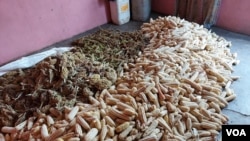Plant scientist Felicity Hayes checks on her crops inside one of eight tiny domed greenhouses set against the Welsh hills. The potted pigeon pea and papaya planted in spring are leafy and green, soon to bear fruit.
In a neighboring greenhouse, those same plants look sickly and stunted. The pigeon pea is an aged yellow with pockmarked leaves; the papaya trees reach only half as tall.
The only difference between the two greenhouse atmospheres - ozone pollution.
Hayes, who works at the UK Centre for Ecology and Hydrology (UKCEH), is pumping ozone gas at various concentrations into the greenhouses where African staple crops are growing. She is studying how rising ozone pollution might impact crop yields - and food security for subsistence farmers - in the developing world.
Ozone stress also reduces plants' defences against pests.
A 2018 study in the journal Global Change Biology estimated global wheat losses from ozone pollution totalled $24.2 billion annually from 2010 to 2012.
In a January paper published in Nature Food, researchers tallied some $63 billion in wheat, rice and maize losses annually within the last decade in East Asia.
Scientists are particularly worried about Africa, which will see more vehicle traffic and waste burning as the population is set to double by mid-century.
That means more ozone pollution, a major challenge for smallholder farmers who make up 60% of the population in sub-Saharan Africa.
"There is a serious concern that ozone pollution will affect yields in the long run," said senior scientist Martin Moyo at the International Crops Research Institute for the Semi-Arid Tropics in Zimbabwe.
He called out an "urgent need for more rural studies to determine ozone concentrations" across the continent.
Earlier this year, scientists with the UK-based non-profit Centre for Agriculture and Bioscience International (CABI) set up ozone monitoring equipment around cocoa and maize fields in Ghana, Zambia and Kenya.
But most African countries do not have reliable or consistent air pollution monitors, according to a 2019 UNICEF report. Among those that do, few measure ozone.
In areas of Africa with high fossil fuel emissions and frequent burning of forests or grassland, new research suggests hotter temperatures could make the problem worse as they can accelerate chemical reactions that create ozone.
Hayes and her colleagues have found that certain African staples are more affected than others.
In a dome filled with a mid-level amount of ozone, North African wheat plants had quickly turned from green to yellow within just a few months.
"You get tiny thin grains that don't have all the good bits in them, a lot of husk on the outside and not as much protein and nutritional value," Hayes said.
That fits with research her team published last year on sub-Saharan plant cultivars, which found that ozone pollution could be lowering sub-Saharan wheat yields by as much as 13%.






